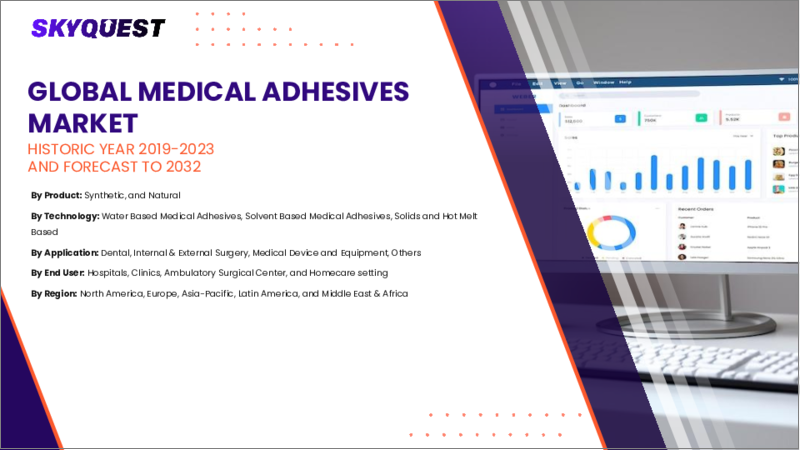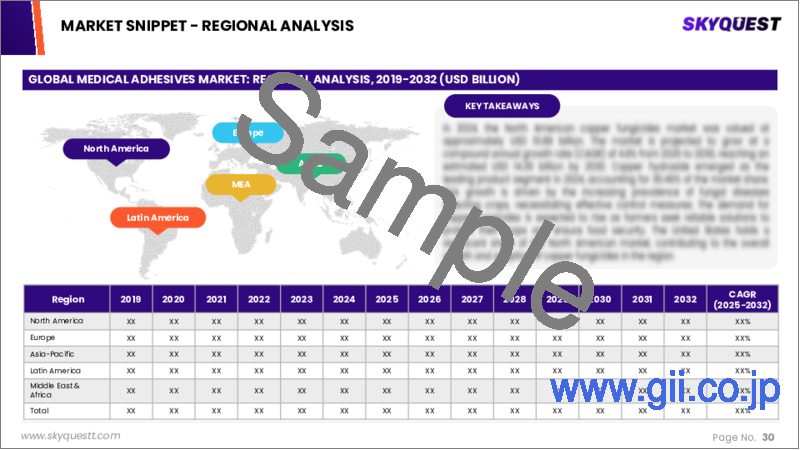|
|
市場調査レポート
商品コード
1619025
医療用接着剤の市場規模、シェア、成長分析、製品別、技術別、天然樹脂タイプ別、合成・半合成樹脂タイプ別、用途別、地域別 - 産業予測、2024~2031年Medical Adhesives Market Size, Share, Growth Analysis, By Product, By Technology, By Natural Resin Type, By Synthetic and Semi-Synthetic Resin Type, By Application, By Region - Industry Forecast 2024-2031 |
||||||
|
|||||||
| 医療用接着剤の市場規模、シェア、成長分析、製品別、技術別、天然樹脂タイプ別、合成・半合成樹脂タイプ別、用途別、地域別 - 産業予測、2024~2031年 |
|
出版日: 2024年12月18日
発行: SkyQuest
ページ情報: 英文 242 Pages
納期: 3~5営業日
|
全表示
- 概要
- 目次
医療用接着剤の世界市場規模は、2022年に88億米ドルと評価され、2023年の94億米ドルから2031年には148億米ドルに成長し、予測期間中(2024~2031年)のCAGRは7.0%で成長する見通しです。
世界の医療用接着剤市場は、パッチ、手術用テープ、創傷ケアソリューションなど、人との接触を必要とする医療用製品の需要増に牽引され、成長する見通しです。ポリイソブチレン(PIB)由来の感圧接着剤(PSA)は、生体組織に効果的に接着し、創傷治癒を促進する能力があるため、経皮ドラッグデリバリーシステムで人気を集めています。さらに、使い捨て医療製品へのシフトは、その費用対効果と相まって、市場の拡大をさらに促進すると予想されます。縫合のような従来の方法に対する医療用接着剤の利点が市場シェアを押し上げている一方で、特にコラーゲンやフィブリンの原材料価格の上昇が課題となっています。また、不健康なライフスタイルに関連した心血管疾患の急増も、心臓手術におけるフィブリンベースの接着剤の需要を押し上げています。
目次
イントロダクション
- 調査の目的
- 調査範囲
- 定義
調査手法
- 情報調達
- 二次データと一次データの方法
- 市場規模予測
- 市場の前提条件と制限
エグゼクティブサマリー
- 世界市場の見通し
- 供給と需要の動向分析
- セグメント別機会分析
市場力学と見通し
- 市場概要
- 市場規模
- 市場力学
- 促進要因と機会
- 抑制要因と課題
- ポーター分析と影響
- 競争企業間の敵対関係
- 代替品の脅威
- 買い手の交渉力
- 新規参入業者の脅威
- 供給企業の交渉力
主な市場の考察
- 重要成功要因
- 競合の程度
- 主な投資機会
- エコシステムマッピング
- 市場の魅力指数(2023年)
- PESTEL分析
- マクロ経済指標
- バリューチェーン分析
- 価格分析
- ケーススタディ
- 規制情勢
- 原材料の分析
- 貿易分析
- 特許分析
医療用接着剤の市場規模:製品別 & CAGR(2024~2031年)
- 市場概要
- 合成
- 天然
医療用接着剤の市場規模:技術別 & CAGR(2024~2031年)
- 市場概要
- 水性医療用接着剤
- 溶剤ベース医療用接着剤
- 固形物およびホットメルトベース
医療用接着剤の市場規模:天然樹脂の種類別 & CAGR(2024~2031年)
- 市場概要
- フィブリン
- コラーゲン
- その他
医療用接着剤の市場規模:合成樹脂と半合成樹脂の種類別 & CAGR(2024~2031年)
- 市場概要
- アクリル樹脂
- シリコン樹脂
- シアノアクリレート樹脂
- エポキシ樹脂
- ポリウレタン
- その他
医療用接着剤の市場規模:用途別 & CAGR(2024~2031年)
- 市場概要
- 歯科
- 義歯接着剤
- 窩洞シーラント
- 歯科修復用接着剤
- その他の歯科用途
- 内科・外科手術
- 心臓血管
- 一般科
- 中枢神経系
- 整形外科
- 泌尿器科
- 美容肺
- 眼科
- その他
- 医療機器
- 針と注射器
- キャサレス
- チューブセット
- マスク
- その他
- その他
医療用接着剤の市場規模 & CAGR(2024~2031年)
- 北米
- 米国
- カナダ
- 欧州
- 英国
- ドイツ
- スペイン
- フランス
- イタリア
- その他欧州地域
- アジア太平洋地域
- 中国
- インド
- 日本
- 韓国
- その他アジア太平洋地域
- ラテンアメリカ
- ブラジル
- その他ラテンアメリカ地域
- 中東・アフリカ
- GCC諸国
- 南アフリカ
- その他中東・アフリカ
競合情報
- 上位5社の比較
- 主要企業の市場ポジショニング(2023年)
- 主な市場企業が採用した戦略
- 市場の最近の動向
- 企業の市場シェア分析(2023年)
- 主要企業の企業プロファイル
- 会社概要
- 製品ポートフォリオ分析
- セグメント別シェア分析
- 収益の前年比比較(2021~2023年)
主要企業プロファイル
- H.B. Fuller
- Johnson & Johnson
- Ashland Inc.
- 3M Company
- Arkema Group
- Henkel AG & Company
- Chemence
- Avery Dennison Corporation
- Dow Inc.
- Cohera Medical, Inc.
- Ethicon Inc.
- Baxter International
- Nitto Denko Corporation
- Braun Melsungen AG
- Scapa Group Plc
- Adhezion Biomedical LLC
- Coviden(Mediatronic PLC)
- Dentsply Sirona
- Permabond LLC
- Masterbond Inc.
結論と推奨事項
Global Medical Adhesives Market size was valued at USD 8.8 billion in 2022 and is poised to grow from USD 9.4 billion in 2023 to USD 14.8 billion by 2031, growing at a CAGR of 7.0% during the forecast period (2024-2031).
The global medical adhesive market is poised for growth, driven by the increasing demand for medical products that require human contact, such as patches, surgical tapes, and wound care solutions. Pressure-sensitive adhesives (PSAs) derived from polyisobutylene (PIB) are gaining traction in transdermal drug delivery systems due to their ability to effectively adhere to biological tissues and facilitate wound healing. Additionally, the shift towards disposable medical products, coupled with their cost-effectiveness, is expected to further enhance market expansion. While the advantages of medical adhesives over traditional methods like stitches are propelling market share, rising raw material prices, particularly for collagen and fibrin, pose challenges. The surge in cardiovascular diseases linked to unhealthy lifestyles also drives demand for fibrin-based adhesives in heart surgeries.
Top-down and bottom-up approaches were used to estimate and validate the size of the Global Medical Adhesives market and to estimate the size of various other dependent submarkets. The research methodology used to estimate the market size includes the following details: The key players in the market were identified through secondary research, and their market shares in the respective regions were determined through primary and secondary research. This entire procedure includes the study of the annual and financial reports of the top market players and extensive interviews for key insights from industry leaders such as CEOs, VPs, directors, and marketing executives. All percentage shares split, and breakdowns were determined using secondary sources and verified through Primary sources. All possible parameters that affect the markets covered in this research study have been accounted for, viewed in extensive detail, verified through primary research, and analyzed to get the final quantitative and qualitative data.
Global Medical Adhesives Market Segmental Analysis
Global Medical Adhesives Market is segmented by Product, Technology, Natural Resin Type, Synthetic and Semi-Synthetic Resin Type, Application and Region. Based on Product, the market is segmented into Synthetic, Natural. Based on Technology, the market is segmented into Water Based Medical Adhesives, Solvent Based Medical Adhesives, Solids and Hot Melt Based. Based on Natural Resin Type, the market is segmented into Fibrin, Collagen, Others. Based on Synthetic and Semi-Synthetic Resin Type, the market is segmented into Acrylic Resin, Silicon Resin, Cyanoacrylate Resin, Epoxy Resin, Polyurethane, Others. Based on Application, the market is segmented into Dental, Internal & External Surgery, Medical Device and Equipment, Others. Based on Region, the market is segmented into North America, Europe, Asia Pacific, Latin America and Middle East & Africa.
Driver of the Global Medical Adhesives Market
The Global Medical Adhesives market is primarily driven by the rising incidence of cardiovascular diseases, which have become a significant health concern due to increasing prevalence linked to unhealthy lifestyle choices. As reported by the World Health Organization (WHO), cardiovascular disease remains the top cause of mortality worldwide, encompassing various conditions such as congenital heart defects, strokes, peripheral artery disease, arrhythmias, congestive heart failure, cardiac arrests, hypertension, and coronary artery disease. In the healthcare sector, medical adhesives, including bandages, surgical tapes, wound care patches, and transdermal patches, are essential. Specifically, cyanoacrylate and fibrin-based adhesives play a crucial role in cardiovascular surgeries by helping to minimize bleeding during procedures.
Restraints in the Global Medical Adhesives Market
The growth of the Global Medical Adhesives market is being hindered by escalating healthcare infrastructure costs. While increasing disposable income may motivate consumers to invest more in healthcare services, this willingness has its limits. Healthcare providers and medical device manufacturers face significant challenges in managing their expenses due to the continuous rise in raw material prices. This financial pressure can lead to restrained budgets and reduced investments in new technologies, ultimately impeding the expansion of the medical adhesives sector. Therefore, addressing these cost-related barriers is crucial for the market's future development and sustainability.
Market Trends of the Global Medical Adhesives Market
The Global Medical Adhesives market is witnessing robust growth, driven by advancements in surgical techniques and an increasing prevalence of chronic diseases requiring effective wound management. The demand for innovative solutions like cyanoacrylate and fibrin adhesives continues to surge, particularly in cardiovascular surgery where rapid hemostasis is critical. Furthermore, the rise of outpatient procedures and minimally invasive surgeries is propelling the use of medical adhesives due to their convenience and effectiveness compared to traditional methods. As healthcare facilities prioritize patient safety and recovery outcomes, the market is expected to expand significantly, supported by continuous research and development in adhesive technologies.
Table of Contents
Introduction
- Objectives of the Study
- Scope of the Report
- Definitions
Research Methodology
- Information Procurement
- Secondary & Primary Data Methods
- Market Size Estimation
- Market Assumptions & Limitations
Executive Summary
- Global Market Outlook
- Supply & Demand Trend Analysis
- Segmental Opportunity Analysis
Market Dynamics & Outlook
- Market Overview
- Market Size
- Market Dynamics
- Driver & Opportunities
- Restraints & Challenges
- Porters Analysis & Impact
- Competitive rivalry
- Threat of substitute
- Bargaining power of buyers
- Threat of new entrants
- Bargaining power of suppliers
Key Market Insights
- Key Success Factors
- Degree of Competition
- Top Investment Pockets
- Ecosystem Mapping
- Market Attractiveness Index, 2023
- PESTEL Analysis
- Macro-Economic Indicators
- Value Chain Analysis
- Pricing Analysis
- Case Studies
- Regulatory Landscape
- Raw Material Analysis
- Trade Analysis
- Patent Analysis
Global Medical Adhesives Market Size by Product & CAGR (2024-2031)
- Market Overview
- Synthetic
- Natural
Global Medical Adhesives Market Size by Technology & CAGR (2024-2031)
- Market Overview
- Water Based Medical Adhesives
- Solvent Based Medical Adhesives
- Solids and Hot Melt Based
Global Medical Adhesives Market Size by Natural Resin Type & CAGR (2024-2031)
- Market Overview
- Fibrin
- Collagen
- Others
Global Medical Adhesives Market Size by Synthetic and Semi-Synthetic Resin Type & CAGR (2024-2031)
- Market Overview
- Acrylic Resin
- Silicon Resin
- Cyanoacrylate Resin
- Epoxy Resin
- Polyurethane
- Others
Global Medical Adhesives Market Size by Application & CAGR (2024-2031)
- Market Overview
- Dental
- Denture Adhesives
- Pit & Fissure Sealants
- Dental Restorative Adhesives
- Other Dental Applications
- Internal & External Surgery
- Cardiovascular
- General
- Central Nervous System
- Orthopaedic
- Urological
- Cosmetic Pulmonary
- Ophthalmic
- Others
- Medical Device and Equipment
- Needles and Syringes
- Catheres
- Tube Sets
- Masks
- Others
- Others
Global Medical Adhesives Market Size & CAGR (2024-2031)
- North America, (Product, Technology, Natural Resin Type, Synthetic and Semi-Synthetic Resin Type, Application)
- US
- Canada
- Europe, (Product, Technology, Natural Resin Type, Synthetic and Semi-Synthetic Resin Type, Application)
- UK
- Germany
- Spain
- France
- Italy
- Rest of Europe
- Asia-Pacific, (Product, Technology, Natural Resin Type, Synthetic and Semi-Synthetic Resin Type, Application)
- China
- India
- Japan
- South Korea
- Rest of Asia Pacific
- Latin America, (Product, Technology, Natural Resin Type, Synthetic and Semi-Synthetic Resin Type, Application)
- Brazil
- Rest of Latin America
- Middle East & Africa, (Product, Technology, Natural Resin Type, Synthetic and Semi-Synthetic Resin Type, Application)
- GCC Countries
- South Africa
- Rest of Middle East & Africa
Competitive Intelligence
- Top 5 Player Comparison
- Market Positioning of Key Players, 2023
- Strategies Adopted by Key Market Players
- Recent Developments in the Market
- Company Market Share Analysis, 2023
- Company Profiles of All Key Players
- Company Details
- Product Portfolio Analysis
- Company's Segmental Share Analysis
- Revenue Y-O-Y Comparison (2021-2023)
Key Company Profiles
- H.B. Fuller
- Company Overview
- Business Segment Overview
- Financial Updates
- Key Developments
- Johnson & Johnson
- Company Overview
- Business Segment Overview
- Financial Updates
- Key Developments
- Ashland Inc.
- Company Overview
- Business Segment Overview
- Financial Updates
- Key Developments
- 3M Company
- Company Overview
- Business Segment Overview
- Financial Updates
- Key Developments
- Arkema Group
- Company Overview
- Business Segment Overview
- Financial Updates
- Key Developments
- Henkel AG & Company
- Company Overview
- Business Segment Overview
- Financial Updates
- Key Developments
- Chemence
- Company Overview
- Business Segment Overview
- Financial Updates
- Key Developments
- Avery Dennison Corporation
- Company Overview
- Business Segment Overview
- Financial Updates
- Key Developments
- Dow Inc.
- Company Overview
- Business Segment Overview
- Financial Updates
- Key Developments
- Cohera Medical, Inc.
- Company Overview
- Business Segment Overview
- Financial Updates
- Key Developments
- Ethicon Inc.
- Company Overview
- Business Segment Overview
- Financial Updates
- Key Developments
- Baxter International
- Company Overview
- Business Segment Overview
- Financial Updates
- Key Developments
- Nitto Denko Corporation
- Company Overview
- Business Segment Overview
- Financial Updates
- Key Developments
- Braun Melsungen AG
- Company Overview
- Business Segment Overview
- Financial Updates
- Key Developments
- Scapa Group Plc
- Company Overview
- Business Segment Overview
- Financial Updates
- Key Developments
- Adhezion Biomedical LLC
- Company Overview
- Business Segment Overview
- Financial Updates
- Key Developments
- Coviden (Mediatronic PLC)
- Company Overview
- Business Segment Overview
- Financial Updates
- Key Developments
- Dentsply Sirona
- Company Overview
- Business Segment Overview
- Financial Updates
- Key Developments
- Permabond LLC
- Company Overview
- Business Segment Overview
- Financial Updates
- Key Developments
- Masterbond Inc.
- Company Overview
- Business Segment Overview
- Financial Updates
- Key Developments






